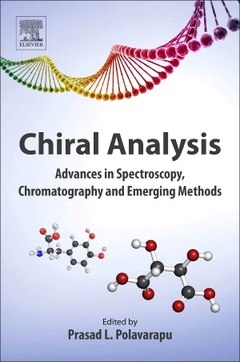Description
Chiral Analysis (2nd Ed.)
Advances in Spectroscopy, Chromatography and Emerging Methods
Coordinator: Polavarapu P.L.
Language: English
Subject for Chiral Analysis:
Keywords
hiral asymmetry; chirality in extraterrestrial life; spectroscopic methods; phase-sensitive detection; chiroptical probe; stereochemistry; CD excitron chirality; vibrational optical activity; vibrational raman optical activity; chiroptical spectra; chiral analysis by NMR spectroscopy; chiral analysis in mass spectrometry; chiroptical spectroscopy; cavity-based chiral polarimetry; chiral rotational spectroscopy; coulomb explosion imaging
790 p. · 15x22.8 cm · Paperback
Description
/li>Contents
/li>Readership
/li>Biography
/li>Comment
/li>
Chiral Analysis: Advances in Spectroscopy, Chromatography and Emerging Methods, Second Edition covers an important area of analytical chemistry of relevance to a wide variety of scientific professionals, including chemistry graduate students, analytical chemists, organic chemists, professionals in the pharmaceutical industry, and others with an interest in chirality and chiral analysis. This thoroughly revised second edition covers several new, important areas of chiral analysis that have emerged since the first edition.
Three of the new methods provide higher sensitivity than can be realized with the current methods and are expected to become mainstream applications: cavity based methods offer vastly higher sensitivity than conventional polarimetric methods, microwave chiral detection provides unsurpassed sensitivity for identifying diastereomers, and the rotating electric field method offers a competing new approach for the separation of enantiomers. Another topic, chirality in extraterrestrial life, has not been discussed in any other book and is important for understanding the origin of life.
Chirality in Nature 1. Chiral Asymmetry in Nature 2. Remote Sensing of Homochirality: A Proxy for the Detection of Extraterrestrial Life Spectroscopic Methods and Analyses 3. Light Polarization and Signal Processing in Chiroptical Instrumentation4. Chiroptical Spectroscopic Studies on Soft Aggregates and Their Interactions5. Vibrational Optical Activity in Chiral Analysis6. Raman Optical Activity7. Chiral Molecular Tools Powerful for the Preparation of Enantiopure Compounds and Unambiguous Determination of Their Absolute Configurations by X-ray crystallography and/or 1H NMR diamagnetic anisotropy8. Chiroptical Probes for Determination of Absolute Stereochemistry by Circular Dichroism Exciton Chirality Method9. Chiral Analysis by NMR Spectroscopy: Chiral Solvating Agents10. Chiroptical Spectroscopy of BiofluidsChromatographic and Electromigration methods 11. Chiral Gas Chromatography12. Chiral Liquid Chromatography13. Enantioseparations by Capillary Electromigration Techniques14. Recent Developments in Chiral Separations by Supercritical Fluid Chromatography15. Chiral Separation Strategies in Mass Spectrometry: Integration of Chromatography, Electrophoresis, and Gas-Phase MobilityEmerging Methods 16. Cavity-based Chiral Polarimetry17. Quantitative Chiral Analysis by Molecular Rotational Spectroscopy18. Chiral Rotational Spectroscopy19. Chiral Analysis and Separation Using Molecular Rotation
Scientific professionals with an undergraduate background in chemistry or a related discipline, specifically analytical chemists, medicinal and organic chemists; researchers in drug discovery, pharmaceutical researchers involved with process analysis or combinatorial libraries; graduate students in chemistry; regulatory food and drugs agencies, environmental agencies
Professor Polavarapu edited a book entitled “Polarization Division Interferometry (John Wiley & Sons, 1997) with a contribution from Dr. John Mather, who won the 2006 Nobel Prize in Physics; published a solo book “Vibrational Spectroscopy: Principles and Applications with Emphasis on Optical Activity (Elsevier, 1998); co-edited two volumes on “Comprehensive Chiroptical Spectroscopy (John Wiley & Sons, 2012), with a contribution from Professor Ben Ferringa, who won the 2016 Nobel Prize in Chemistry. His latest book “Chiroptical Spectroscopy: Fundamentals and Applications (CRC Press, 2016) was written to serve as a text book for graduate level course.
Professor Polavarapu was awarded the Jeffrey Nordhaus Award (in 2010) for excellence in undergraduate teaching at Vanderbilt University. He was elected (in 2012) as a Fellow of the American Association for Advancement of Science (AAAS) for distinguished contributions to the field of chiral molecular structure determination. He was an Erudite Scholar (in No
- Offers the only book to cover both spectroscopic and separation methods in a single volume
- Provides an up-to-date and detailed review of the various techniques available, including new techniques that have emerged since the first edition
- Includes contributions from a range of leading experts in the field, now edited by award-winning chirality researcher Prasad Polavarapu




